Eurocom X5 (Clevo P177SM)
by Vivek Gowri on September 2, 2013 12:00 AM ESTWhen it comes to large gaming notebooks, battery life is never really a concern, but since NVIDIA’s Optimus graphics switching technology basically became standard on all Intel/NVIDIA notebooks across the board, it’s actually been possible to see a solid few hours of life out of this class of system. The sheer size of the notebooks typically allows for 90-100Wh batteries that would be considered absolutely massive by normal standards, so with the large display and high TDP quad, we’ve been seeing Haswell gaming notebooks end up in the 4 hour range for web-browsing battery life.
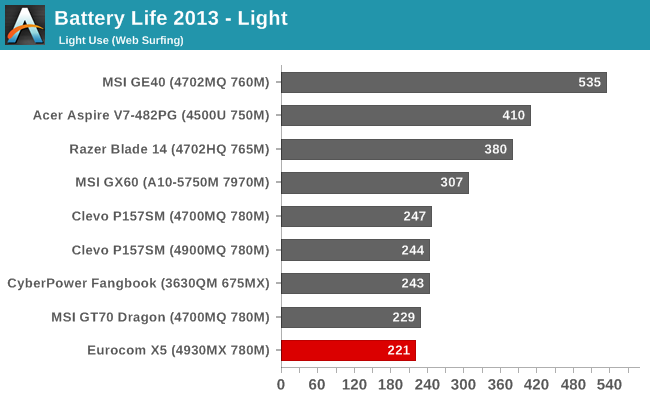
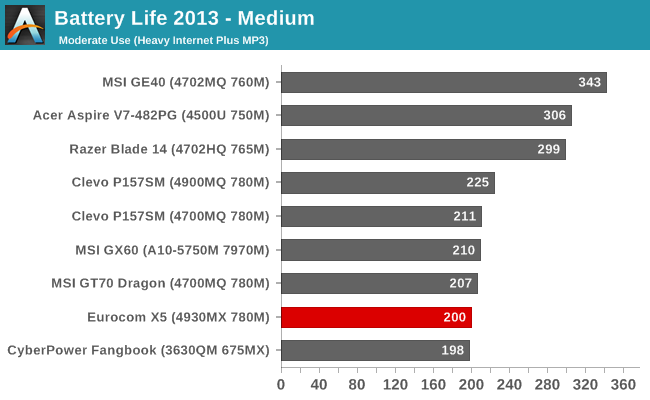
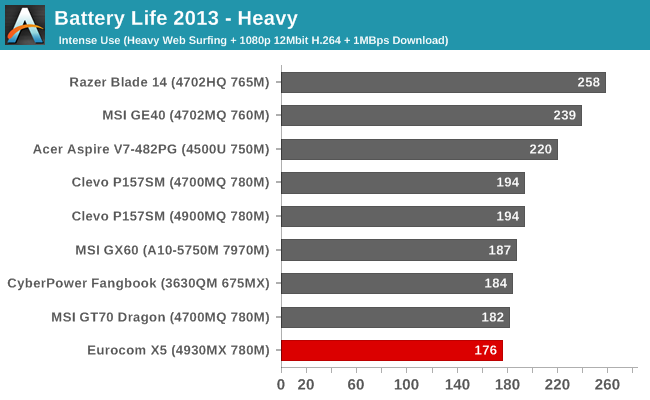
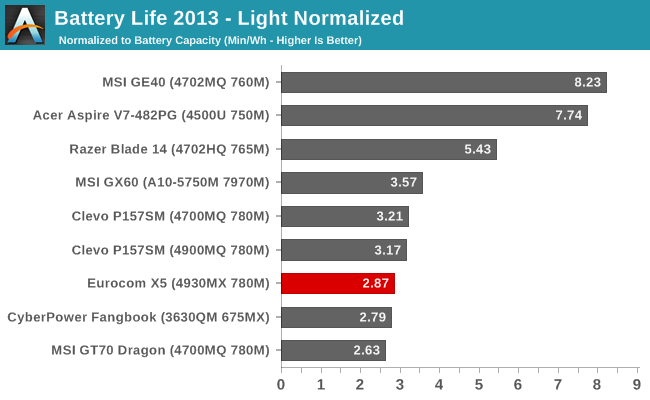
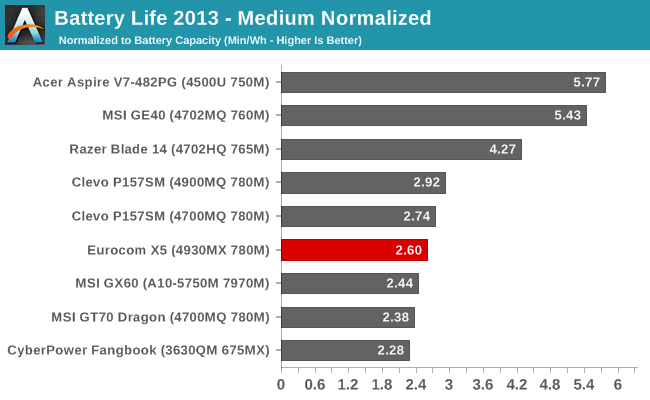
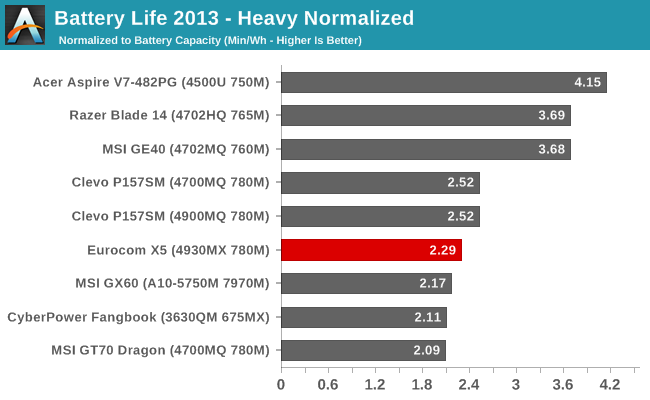
That’s honestly pretty impressive; I still remember the days when the batteries in 17” Alienwares and Clevos almost served more as uninterruptible power supplies than any kind of mobile power source. An hour or two would be considered good back then. Obviously, both CPU and GPU microarchitectures have gotten far more efficient in the last handful of years, and Optimus really changed things for the better.
None of our battery tests stress the CPU enough for the extra 10W TDP of the Extreme Edition to make a discernible difference in terms of battery life relative to the lower end mobile quads. Battery life is slightly lower than the Clevo P157SM we tested, but that had less RAM, a smaller LCD, and a single SSD (instead of an SSD and HDD), so a slight reduction in battery life is expected.
Our battery tests aren’t that intensive, mostly focusing on internet, music, and video use cases; there’s a lot of CPU idle time where we already know that Haswell excels, so this is no real surprise. Between the CPU and GPU, this system has a thermal envelope of roughly 160W under load, so the 77Wh battery would go pretty quickly under any sort of intensive workload (like gaming).










38 Comments
View All Comments
frakkel - Monday, September 2, 2013 - link
After been seen some reviews of laptops I begin to think that it is only possible to have 16:9 displays for standard windows pc´s and 16:10 displays for osx. Is this correct?I would love to have a windows pc with 16:11 or at least 16:10.
xTRICKYxx - Monday, September 2, 2013 - link
Is it possible for an OEM to make a 16:10 display for a Windows notebook? Absolutely. They just don't think there is a good reason to.ShieTar - Tuesday, September 3, 2013 - link
Panasonic is selling their Toughbook with 16:10 screens. It doesn't seem to magically make them a big player in the notebook market. I assume, the majority of buyers don't really care. I used to, when we lost 4:3, but now I got used to it and can live with 16:9 without really feeling any drawbacks.1Angelreloaded - Monday, September 2, 2013 - link
Dell among others have a wide array of formats for screens resolution and size. This isn't Apple's walled garden in the PC world you can plug anything in as long as the connector is supported.mfenn - Monday, September 2, 2013 - link
" The layout was decent, as well, though I’m really struggling to understand why some companies are moving the Fn key to the right side of the spacebar. It’s the wrong side of the keyboard, guys. In day to day use, it just feels unnatural. "If by "wrong", you mean "right", then sure. Disrupting the normal left-hand side Ctrl-Super-Alt cluster with another key is a cardinal sin. I'm glad that Clevo avoided it with this keyboard.
JarredWalton - Monday, September 2, 2013 - link
I'm with Vivek and totally disagree with your opinion. It frustrated me on the P157SM as well, but of course some of it is simply "old habits". But not all -- try doing Home/End with the Fn key on the right and you have two options:1) Press Fn with the thumb and stretch your hand to hit PgUp/PgDn with a finger (pinky or ring seems most natural to me, and neither is really ideal)
2) Move your left hand over to press Fn and then press PgUp/PgDn with your right hand.
Something else is that the placement of Fn to the right of the space bar has shifted the space over to the left. On a standard keyboard, space stretches from the C key to the comma; on the Clevo keyboard it's off center and stretches from X to M. It's not the end of the world, but I suspect there are going to be a majority of people out there that prefer Fn on the left side.
Gc - Monday, September 2, 2013 - link
As a touch-typist who makes frequent use of the alt-key, I prefer an alt-key that overlaps the 'c' key. The position on the clevo keyboards, to the left of the 'x' key, brings back painful memories from when I used such a keyboard. Trying to reach it with either the left pinky or left thumb while the rest of the fingers are over the home keys causes some twisting strain after just a few hours. (I imagine such keyboards are designed by someone who has an extra finger coming out of the front of their palm. I suppose one could glue a small foam key extender to the top of the alt key, then you could press it with the palm side of your knuckles or something, but it might be hard to type another key at the same time with the same hand, and it would be hard to close the screen. :)whyso - Monday, September 2, 2013 - link
I love it when they put (and make you pay for) a super fast CPU but don't put enough cooling in it so it gets beaten by a competitor's much cheaper system. That's why a lot of times it makes more sense to buy a notebook for its cooling system and not its CPU/GPU.JarredWalton - Monday, September 2, 2013 - link
Most of the instances where the Eurocom numbers are slower than the Mythlogic results are likely due to drivers. Vivek tested this a few weeks ago and there were some delays in getting it finalized and posted, so I think he may have used 311.27 NVIDIA drivers as opposed to 326.xx. The laptops have all gone back now, so unless he noted this I don't even know for sure what BIOS, drivers, etc. he used.whyso - Monday, September 2, 2013 - link
Will drivers affect CPU performance. It should be better than the 4900 in stuff like cinebench. Its barely better than the 4700mq.